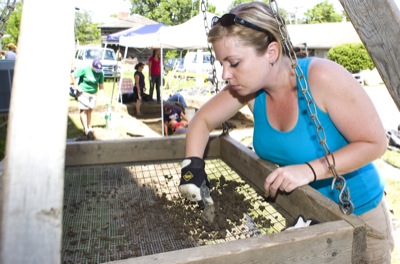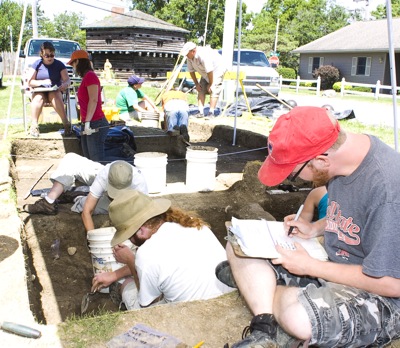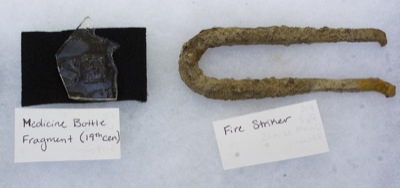Tuesday, June 14th, 2011
Students unearthing Fort's past
By William Kincaid

Photo by Mark Pummell/The Daily Standard
Ball State University archeology student Ellen Botkin sifts through dirt taken from a dig site of the original fort wall.
FORT RECOVERY - A team of archeologists likely has discovered the location of the east-west palisade wall of Fort Recovery's original fort built in 1793.
During a press conference Monday morning, Ball State University archaeologist Mark Groover showed a 17-foot trench at the corner of Boundary and Fort Site streets believed to be the site of the former fort.
"It's pretty neat - it's hidden in plain sight," Groover said about the find on the small parcel of land across the street from Fort Recovery State Museum.
The discovery was made by 15 Ball State University students completing a five-week field study in Fort Recovery.
Museum manager Nancy Knapke said the find came about quickly, as Groover and his crew were excavating three sites near the reconstructed fort. Fellow university archeologist Chris Keller, a Fort Recovery native, found several abnormalities while conducting a ground penetrating radar survey.
Excavation revealed the clay surface of the trench as well as several post holes that likely held the timbers constituting the former fort wall, Groover said.
Also, several period artifacts - led-glazed flowering pots, ceramics, shells, a fire-striker, a scissors, lantern hardware and the middle bracket of a 1766 Charleville Musket - were found in or near the post holes.
The artifacts will be studied at the university and likely returned to the Fort Recovery museum, Groover said.
The finds were verified by S. Homes Hogue, the chairperson of the university's department of anthropology.
Groover said the trench line is aligned with the Greenville Treaty Line established after the Battle of Fort Recovery in 1794 between American Indians and U.S. troops led by Gen. Anthony Wayne.
Groover believes U.S. surveyor Israel Ludlow at the end of the 18th century may have used the east-west wall of the original fort as a map landmark to indicate the boundary line of the treaty - one he said was almost immediately violated by incoming settlers.
The public is invited to visit the excavation site until 5 p.m. today. Archeologists will explain the process, findings and future ramifications of the find.
Groover said the site will be filled in at the end of the week, as the field study concludes. Future excavation and exploration may occur, he added.
"It's just about as exciting as it can be," Knapke said about the find.
The field study was part of a $70,000 federal grant awarded to Fort Recovery and Ohio historical societies and Ball State University to study the 1791 Battle of the Wabash and the Battle of Fort Recovery.
"The whole goal is to make informed decisions about battlefields," Knapke said.
Knapke said the location of the find could have been a parking lot if one member of the local historical society wouldn't have been so adamant about not paving over the land several years ago.
"What a fortunate occurrence and a perfect example of what this current American Battlefield Protections Program grant is all about - informed decision-making," Knapke said.
The discovery of the possible location of the fort wall probably did more for the spirit of the grant than anything else, Knapke said.
Keller continues to conduct geophysical archaeology work on 23 acres of land in northwest Fort Recovery. She is searching for artifacts and subsurface foundations to further delineate the boundaries of the battles fought in the village more than 200 years ago.
She will present her findings to the community Oct. 2 during the museum's archaeology day. A formal report also will be presented to the National Park Service in December, she said.

Photo by Mark Pummell/The Daily Standard
Students from Ball State University, Muncie, Ind., work on an excavation site in Fort Recovery. On Monday, they announced they had found the site of the east-west wall of the original fort built in 1793. The public can view the site until 5 p.m. today.

Photo by Mark Pummell/The Daily Standard
Artifacts from the 1790s are on display at an excavation site in Fort Recovery.
